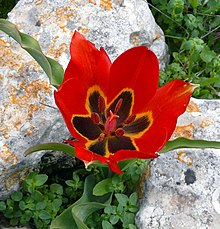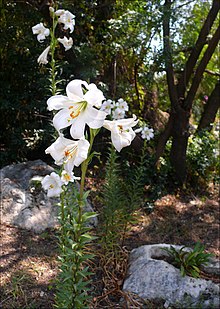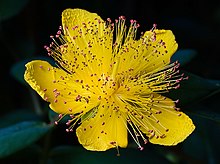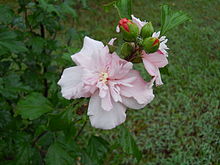Rose of Sharon
Rose of S (ch) aron , Blume in S (ch) aron , Blume (n) zu S (ch) aron , Blume des Scharon or S (ch) aronsblum (e) are trivial names based on a biblical quotation that appear in different ways are used by flowering plants that are valued all over the world. However, with regard to the use of such trivial names, the problem must be pointed out that their lack of accuracy can lead to confusion and misunderstandings. The terms “Rose of Sharon”, “Saronsblume” and related names such as the Latin form “ flos campi ” also became frequently used expressions in poetry and music. The English form Rose of Sharon also exists as a female given name.
Biblical origins
Hebrew formulation and translations

Chavatzelet HaSharon (Hebrew חבצלת השרון) is the name for a flower bulb . The Hebrew word חבצלת ( ḥăḇaṣṣelaṯ ) denotes a flower of unknown identity, which in German Bible translations of Hld 2,1 LUT with
- Flower in Sharon (revised Luther Bible )
- Narcisse of the Saronsflur ( Text Bible)
- Narcissus by Sharon (Elberfelder)
- Daffodil in the Sharon Plain (Hope for All)
- Daffodil by Saron (butcher)
- Spring flower [...] as it [grows] in the meadows (Good news, with the reference to Narcissus (?) By Sharon as a literal translation)
- Flower in the meadows of Sharon (standard translation)
- Rose of Sharon (New Life)
- Lily of Sharon (New Evangelistic Translation)
and in the Vulgate with
- flos campi ( flower of the field ; Hld 2,1 is the only place, at least in the protocanonical books of the Vulgate, where flos campi can be found in precisely this grammatical form)
is named.
Identifications
Etymologists have reluctantly associated the biblical word חבצלת with the words בצל beṣel , meaning “onion”, and with חמץ ḥāmaṣ , also transliterated with Chametz , here possibly with the meaning “sharp” or “excellent”. ( The Analytical Hebrew and Chaldee Lexicon ). Already in the Luther Bible of 1545 there is the formulation a flower for Saron ; the English name rose of Sharon appears for the first time in 1611 in the King James Bible . According to a comment on Hld 2.1 by the Translation Committee of the New Revised Standard Version , this is a mistranslation of a more general Hebrew word for crocus . It was certainly not a rose in the botanical sense, since it did not appear in Israel in biblical times.
One possible interpretation of the biblical reference is the dune funnel-shaped daffodil ( Pancratium maritimum ), which blooms in late summer just above the tide line. The Hebrew name of this plant is חבצלת or חבצלת החוף (beach ḥăḇaṣṣeleṯ ). Since it also grows in the Sharon Plain of the Mediterranean coast, there is a possibility that the Bible passage refers to this plant. The saintly legend of the Restituta of Africa claims that dune-funnel daffodils bloomed when their corpse landed on Ischia .
Various scholars have suggested that the Biblical rose of Sharon could be one of the following plants:
- the oat root ( Tragopogon porrifolius ), with which it identified Albertus Magnus ;
- a kind of rockrose ( Cistus ), as Carl von Linné said;
- a crocus or similar plant that grows in the coastal area of the Sharon Plains ( New Oxford Annotated Bible );
- a gladiolus ( Gladiolus );
- the mountain tulip ( Tulipa montana ), "a bright red tulip-like flower ... which now thrives in the hills of Sharon" ( rose In: Harper's Bible Dictionary );
- the sun-eye tulip ( Tulipa agenensis ) or sharon tulip, a species of tulip suggested by some botanists;
- the ostrich daffodil ( Narcissus tazetta );
- the Madonna lily ( Lilium candidum ), a species of lily suggested by some botanists, but which could be more likely meant with the “lily in the valley” mentioned in the second part of Hld 2,1.
At present, some scholars insist on translating ḥăḇaṣṣeleṯ as “a sprouting onion,” using different language versions and lexicons in the analysis.
Modern use
The name “Rose of Sharon” is generally used for two different plants that are native to outside the Levant and therefore cannot be considered as the biblical plant:
- the Großkelchige St. John's Wort ( Hypericum calycinum ), an evergreen shrub of blooming Southeast Europe and South-West Asia;
- the Straucheibisch ( Hibiscus syriacus ), a deciduous shrub from East Asia.
Cultural history
Many post-biblical poets mentioned the rose of Sharon or the saron flower . Here are some examples of how the term can be used:
Before the 18th century
- The oldest known host iron for making altar breads from Carthage in the 6th or 7th century, i.e. from the time before the city was destroyed by the Arabs, has the inscription Hic est flos campi around the Christ monogram based on Hld 2,1 et lilium (“This is a flower of the field and a lily”). Here, then, the Christ present in the sacrament of the Lord's Supper is equated with the rose of Sharon.
- The rose of Sharon in equation with the hibiscus ( Hibiscus syriacus ) is the national flower of South Korea . The first mention of a cultivation of this plant ( mugunghwa : 무궁화) in Korea is found in a 1400 year old article. The mythological story Xuanzhongji ( Hanja : 玄 中 記), written during the Eastern Jin Dynasty (Hanja: 東晉) of China, mentions that "The Land of Wise Men extends over 1000 li, where mugunghwa flowers bloom in abundance" (君子 之 國 , 地方 千里 , 多 木槿 之 華). The name mugunghwa was first used by the poet Lee Gyu-bo (이규보, 1168-1241) during the Goryeo dynasty .
- The Sephardic poetry of the 10th to 15th centuries makes extensive use of the word חבצלת (ḥăḇaṣṣeleṯ), which is always rendered in English translations with “Rose of Sharon”, exceptionally also with “lily”. (See Gate 47 of the Tahkemoni .) The term can be found throughout the Sefer Tahkemoni of Juda al-Charisi (1165-1225) and in a large part of the work of the so-called golden age of the Iberian-Jewish belles lettres , which are works by poets such as Shmuel ha-Nagid (993-1056), Moses ibn Esra (around 1055-after 1138), Yehuda Halevi (around 1075-1141), Abraham ibn Esra (around 1093 to around 1167) and others.
- Gabriel von Lebenstein wrote a short treatise on “distilled waters” at the end of the 14th century. (Oldest manuscript: Wolfenbüttel, Herzog August Bibliothek, Cod. 54 Aug. 4 °, Bl. 19r-24r, 1st quarter of the 15th century) There it says about the Rose of Sharon: “Flos campi die rotten. It is constantly written in the book of the mynnenden sel, it has also spoken from our love fraw through jren junckfrawlichen mouths: I am a plvm and am hoisted flos campi. ”The speaker of Hld 2,1 ( Sulamith ) is here with Maria, der Mother of Jesus , identified. Which plant Gabriel von Lebenstein equated the flos campi with is unknown, possibly with the oat root with which Albertus Magnus identified it in the 13th century.
- In 1539 Ego flos campi appeared in book I of Nicolas Gombert's five-part motets in the tenth place .
- Clemens non Papa (1510 to around 1557) wrote the motet Ego flos campi in the autumn of 1550 to Hld 2,1-2 VUL and Hld 4,15 VUL . (Sound file available under Saturday Chorale )
- Jacobus Vaet (1529–1567), a pupil of Clemens non Papa, used his motet for his mass Missa Ego flos campi . ( Released as a CD by the Ensemble Cinquecento . A recording was made in 2009 with the participation of Terry Wey .)
- Francisco Guerrero wrote in Venice in 1589, the eight-part motet Ego flos campi to Hld 2.1 to 5 VUL . (PDF sheet music on the University of Málaga website )
- Leonhard Lechner (around 1553–1606) wrote the motet Ich bin ein Blumen zu Saron (fifth part of Das Hohelied Salomonis ) to Hld 2,1-6 LUT . (Sheet music as PDF on the IMSLP website )
- Claudio Monteverdi (1567–1643) wrote the unanimous motet Ego flos campi et lilium convallium (SV 301) in 1624 for Hld 2,1-3 VUL .
- Dieterich Buxtehude (around 1637–1707) wrote the cantata I am a flower to Saron ( BuxWV 45, Edition Butorac Munich 2012) to Hld 2,1-3 LUT . (Sound file available at Saturday Chorale , sheet music as PDF at Saron.de )
18th century
- In 1726, Johann Heinrich Reitz had Georg Balthasar's biography in the History of the Reborns followed by a poem that mentions the rose of Sharon as Sarons-Blum . Only the first two stanzas that refer to this plant are quoted here:
You must be small and poor in heart and mouth / when should Christ go open
in your bottom:
For the rose and viol
grow in the valley of the lower souls /
who choose nothing high here!
May you only be as humble
as the nidre Sarons = Blum /
And accordingly stand respectfully
And bow down before God = crooked:
So you should soon have the gifts of
His Spirit in you.
- The poem became known through its inclusion as a folk song text in Achim von Arnim's first volume of the song collection Des Knaben Wunderhorn , published in 1805 under the title Become a Child .
19th century
- The English Baptist pastor Charles Haddon Spurgeon (1834-1892) related the term the Rose of Sharon in the context of Hld 2,1-2 and elsewhere to Christ:
- “'I am a flower to Saron.' It was the best and rarest of all roses. The Lord Jesus is not just 'a rose', but He is the 'Rose of Saron', just as He calls his righteousness 'gold' and then adds: 'Gold from Ophir', the best of all the best. "
- "Take the rose of Saron, and take one leaf after the other and place it between the leaves of your memory, you will find out that for a long time afterwards it gives off its delicious scent and fills the whole house with fragrance. Christ perfectly satisfies the noblest taste of the educated heart and mind. The pickiest lover of fragrances is quite satisfied with the scent of the rose; and when the soul has reached the highest level of true taste, it is nevertheless drawn again and again to Christ, yes, it only values him all the more. Heaven itself has nothing that this rose to Saron would transfer. "
- “Beloved of all names above, my Savior and my God, you are always glorious, but in my eyes you are never more lovable than when you are clothed in shameful mockery. He is both in one, the lily of the valley and the rose of Saron, shining in the perfection of his character and blood red in the magnitude of his sufferings. "
- “It is the incessant tumult of the world, the constant attention to the ephemeral, that pulls the soul away from Christ. While memory is only too willing to harbor a poisonous weed, the Rose of Saron lets it wither. "
- “My soul, have you picked the flower from Saron?”… “With this flower from Saron in your hand you will find your way to the throne of God himself, because even heaven has nothing that surpasses its radiant beauty, and of all flowers that bloom in paradise is none that can be compared to the rose in the valley. My soul, take the blood-red rose of Golgotha in your hand through faith, carry it through love, preserve it through community, so you will be exceedingly happy above all imagination. "
- The Texas village of Rosharon is named for the rose of Sharon that is used here to identify the Cherokee roses ( Rosa laevigata ) that grow nearby. In 1900 the engineer George Wetmore Colles, Jr. (1871-1951) acquired a piece of land near the initially unnamed place, which he named Rose of Sharon Garden Ranch because of the abundance of plants . Colles also provided the town with water.
20th century
- In My Childhood (created 1913–1914) Maxim Gorky also refers to the “Rose of Sharon” through one of the characters.
- In 1925 Ralph Vaughan Williams completed his composition Flos Campi: suite for solo viola, small chorus and small orchestra , which he named after the Vulgate name of the Rose of Sharon.
- In The Fruits of Wrath (published 1939) by John Steinbeck , Rose of Sharon (also Rosasharn ) is a main character, the oldest daughter of the Joad family and sister of the protagonist Tom Joad. For much of the novel, she is portrayed as fragile because of her pregnancy.
- Shoshanat HaAmakim (founded 1951) is a communal settlement in central Israel.
- Leonard Bernstein's 1963 Kaddish Symphony took the form of a monologue by a narrator who identified himself with the Chavatzelet HaSharon, “the lily that has been picked and thrown away”.
- On April 13, 1967, Ovie E. Lattimore founded the Rose of Sharon Community Church, located in Plainfield, New Jersey .
- Leonard Cohen (1934-2016) also refers to the rose of Sharon in his poem The Traitor (on which the song The Traitor , written around 1975) is based.
- Rose of Sharon is a song by Robert Hunter ( Grateful Dead ) that he released in his 1975 solo album Tiger Rose .
- In the USA the hibiscus is the official flower of the national Lutheran-oriented corporation Phi Beta Chi (founded on March 26, 1978) as the White Rose of Sharon .
- Bob Dylan refers to the rose of Sharon in the song Caribbean Wind . This appeared in the scrapbook Biograph , but was already recorded during the recordings for Shot of Love , around 1980.
- In Canada, the Rose of Sharon is a charity that helps pregnant women and young mothers under 25. Their founding process began in 1982.
- The song King's Ransom from the year 1986 by Petra , appeared in the album Back to the Street , symbolized in its text with the rose of Sharon Jesus Christ .
- In Brazil, Rosa de Saron (Portuguese for "Rose of Sharon") is the name of a well-known Roman Catholic rock group founded in 1988 that has also recorded some songs in English.
- On April 14, 1989, the first service of the Rose of Sharon Lutheran Church in New Egypt , New Jersey took place. In December 2003, the ward purchased its own church building in Jacobstown , New Jersey.
- The song Rose of Sharon can be found in the album Dust and Dreams (released 1991) by Camel .
- A reference to the Rose of Sharon can also be found in Kate Bush's recording The Song of Solomon from her album The Red Shoes from 1993.
- Rose of Sharon is a song that Eliza Gilkyson wrote and sang for her 1997 album Redemption Road .
21st century
- Rose of Sharon is a homeless character in Sherman Alexie's short story What You Pawn I Will Redeem , published April 21, 2003 in The New Yorker .
- The Rose of Sharon is featured in the song Rose of Sharyn by Killswitch Engage on their 2004 album The End of Heartache .
- The background music for Ragnarok Online (first published April 15, 2004) includes a soundtrack called "Rose of Sharon".
- A song entitled Rose of Sharon can be found in Xiu Xius 2005 album La Forêt . The text seems to refer to both the Song of Songs and Steinbeck's novel.
- From January 2005, Carolyn Baskin-Bell ran the founding of the Rose of Sharon AME Church in Norwalk, California . On Sunday, June 17th, 2006, the first official service of the newly established congregation, which belongs to the African Methodist Episcopal Church , took place. The motto of the congregation is translated: "A church that gives off the fragrance of Jesus Christ."
- Around 2008, Sharon R. Peters founded the Sweet Rose of Sharon Women's Ministry as a "Place of Nourishment, Strengthening, and Restoration" to provide a Christian forum for women only.
- Judah Robertson named one of his albums Rose of Sharon (released January 1, 2008).
- Rose of Sharon is a song sung by Joan Baez for the album Day After Tomorrow (released September 9, 2008).
- Rose of Sharon Cassidy is a character in the video game Fallout: New Vegas (released October 19, 2010). It suggests that it is named after the character of Steinbeck.
- Rose of Sharon is the name of a song on Title Fight's Hyperview album , which was released in 2015.
literature
- PL Crawford: Rose . In: Paul J. Achtemeier (Ed.): Harper's Bible Dictionary . Harper, San Francisco 1995, p. 884.
- Benjamin Davidson [1848]: The Analytical Hebrew and Chaldee Lexicon , 1st softcover ed. Edition, Zondervan, Grand Rapids, Michigan 1978, ISBN 0-310-39891-6 , p. 246.
- NL Lapp: Sharon . In: Paul J. Achtemeier (Ed.): Harpers Bible Dictionary . Harper, San Francisco 1985, pp. 933-4.
- RBY Scott: Annotations to Song of Solomon . In: The New Oxford Annotated Bible . Oxford University Press, New York 1991, p. 854 OT.
Individual evidence
- ^ Botanic Gardens Trust, Sydney, Australia: Why use a scientific name? ( Memento from September 5, 2015 in the Internet Archive )
- ↑ Rose of Sharon Witmer: Alvin "Red" Tyler Biography. In: All Music Guide. Retrieved November 21, 2008 .
- ↑ Text Bible on Bibeltext.com
- ↑ Beloved ones are praised and described. ( English ) churchofjesuschrist.org. Retrieved October 13, 2019.
- ↑ Contribution to the festival of Restituta on benessereischia.it
- ↑ Ischia anthology on larassegnadischia.it
- ^ Travel tip Ischia on Süddeutsche.de
- ^ Carl Jessen , Ernst Heinrich Meyer : Alberti Magni ex Ordine Praedicatorum. De vegetabilibus libri VII: historiae naturalis pars XVIII. Reimer, Berlin 1867. Digitized version of the Bavarian State Library . Book VI / 404 (p. 546 f): ( Tragopogon porrifolius Lin.) Oculus porci est flos, qui flos campi vocatur, crescens in altis locis siccis iuxta vias, habens radicem delectabilem, propter quod comeditur, et a porcis in pastum effoditur; et habet stipitem parum altum, in cuius supremo est flos rutilans ipse multum, et exsiccatus retinet eundem colorem. Folia autem habet parva et stricta, et profert florem in theca valde fusca. Est autem calidus et siccus temperate.
- ^ Mythological Associations of the Rose of Sharon on Paghat.com
- ↑ Rose of Sharon on the Flowers in Israel website
- ↑ Satoshi Mizota. Origin of 'Rose of Sharon': An Analysis of Various Translations Having a Bearing on The Authorized Version Text. Dissertation for MA: Aich University, 2008. http://ir.lib.hiroshima-u.ac.jp/metadb/up/diss/MizotaSatoshi_Origin-of-Rose-of-Sharon.pdf ( Memento from February 22, 2014 in Internet Archive )
- ↑ cf. Article: “Saron” in: Der Große Brockhaus: Handbook of Knowledge in twenty volumes. 21 volumes. Brockhaus, Leipzig 15 1928–1935; Volume 16: Roq-Schq , p. 455.
- ^ Henri Leclercq, in The Catholic Encyclopedia. Volume 7. Robert Appleton Company, New York 1910. Sept. 10, 2013.
- ↑ Judah Alharizi: The Book of Tahkemoni , English translation: David Simha Segal. The Littman Library of Jewish Civilization, London 2001.
- ↑ Cole, Peter. The Dream of the Poem . English translation: Peter Cole. Princeton University Press, Princeton. 2007.
- ↑ Description by Dave Lewis on AllMusic
- ^ Description by Donato Mancini on AllMusic
- ↑ Johann Henrich Reitz: History of the re-drilling. Part 5 , second history / by Johanne Jessenio , famous Doctor Medicinae, and by Georg Balthasar / a simple-minded farmer in Bohemia.
- ↑ Hans-Jürgen Schrader: "Become a child!" In the "Wunderhorn": Pietistic dowries to romanticism in: Wolfgang Breul, Marcus Meier and Lothar Vogel (editors): Der radical Pietismus , Vandenhoeck & Ruprecht, Göttingen 2010, ISBN 978- 3-525-55839-3 (printed) and ISBN 978-3-647-55839-4 (e-book), Volume 55 of the series Hans Schneider, Christian Bunners and Hans-Jürgen Schrader (ed.): Works on the history of Pietism.
- ↑ Charles Haddon Spurgeon on Saron.de, here two short interpretations of Hld 2,1-2 can be viewed
- ^ The message of salvation in sermons by CH Spurgeon, preacher in London. 1875. No. 11. Ludwig Koch publishing house in Hamburg. Printed by the Koch brothers.
- ↑ Spurgeon's devotion to 1 Cor 11:24
- ↑ Spurgeon's devotion to Rev 3, 7 ( memento of the original from March 5, 2016 in the Internet Archive ) Info: The archive link was automatically inserted and not yet checked. Please check the original and archive link according to the instructions and then remove this notice.
- ^ Homepage of the Rose of Sharon Community Church
- ^ Rose of Sharon: Services for Young Mothers . Archived from the original on June 9, 2008. Retrieved September 2, 2014.
- ^ Homepage of the Rose of Sharon Lutheran Church
- ^ Homepage of the Rose of Sharon AME Church
- ^ Homepage of the Sweet Rose of Sharon Women's Ministry













